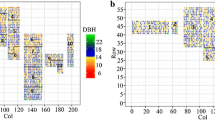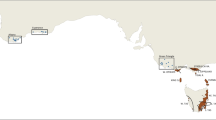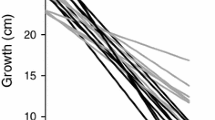Abstract
Conventional analysis of spatially correlated data in inadequately blocked field genetic trials may give erroneous results that would seriously affect breeding decisions. Forest genetic trials are commonly very large and strongly heterogeneous, so adjustments for micro-environmental heterogeneity become indispensable. This study explores the use of geostatistics to account for the spatial autocorrelation in four Pinus pinaster Ait. progeny trials established on hilly and irregular terrains with a randomized complete block design and large blocks. Data of five different traits assessed at age 8 were adjusted using an iterative method based on semivariograms and kriging, and the effects on estimates of variance components, heritability, and family effects were evaluated in relation to conventional analysis. Almost all studied traits showed nonrandom spatial structures. Therefore, after the adjustments for spatial autocorrelation, the block and family × block variance components, which were extremely high in the conventional analysis, almost disappeared. The reduction of the interaction variance was recovered by the family variance component, resulting in higher heritability estimates. The removal of the spatial autocorrelation also affected the estimation of family effects, resulting in important changes in family ranks after the spatial adjustments. Comparison among families was also greatly improved due to higher accuracy of the family effect estimations. The analysis improvement was larger for growth traits, which showed the strongest spatial heterogeneity, but was also evident for other traits such as straightness or number of whorls. The present paper demonstrates how spatial autocorrelation can drastically affect the analysis of forest genetic trials with large blocks. The iterative kriging procedure presented in this paper is a promising tool to account for this spatial heterogeneity.







Similar content being viewed by others
References
Anekonda TS, Libby WJ (1996) Effectiveness of nearest-neighbor data adjustment in a clonal test of redwood. Silvae Genet 45:46–51
Costa-Silva J, Dutkowski GW, Gilmour AR (2001) Analysis of early tree height in forest genetic trials is enhanced by including a spatially correlated residual. Can J For Res 31:1887–1893
Cressie NAC (1993) Statistics for spatial data. Wiley, New York
Dutilleul P (1993) Spatial heterogeneity and the design of ecological field experiments. Ecology 74:1646–1658
Dutkowski GW, Costa-Silva J, Gilmour AR, Lopez GA (2002) Spatial analysis methods for forest genetic trials. Can J For Res 32:2201–2214
Ettema CH, Wardle DA (2002) Spatial soil ecology. Trends Ecol Evol 17:177–182
Fu YB, Clarke GPY, Namkoong G, Yanchuk AD (1998) Incomplete block designs for genetic testing: statistical efficiencies of estimating family means. Can J For Res 28:977–986
Fu YB, Yanchuk AD, Namkoong G (1999) Spatial patterns of tree height variations in a series of Douglas-fir progeny trials: implications for genetic testing. Can J For Res 29:714–723
Gallardo A (2003) Spatial variability of soil properties in a floodplain forest in Northwest Spain. Ecosystems 6:564–576
Gallardo A, Covelo F (2005) Spatial pattern and scale of leaf N and P concentration in a Quercus robur population. Plant Soil 273:269–277
Gilmour AR, Cullis BR, Verbyla AP (1997) Accounting for natural and extraneous variation in the analysis of field experiments. J Agric Biol Environ Stat 2:269–293
Grondona MO, Crossa J, Fox PN, Pfeiffer WH (1996) Analysis of variety trials using two-dimensional separable ARIMA processes. Biometrics 52:763–770
Hamann A, Namkoong G, Koshy MP (2002) Improving precision of breeding values by removing spatially autocorrelated variation in forestry field experiments. Silvae Genet 51:210–215
Joyce DG, Ford R, Fu YB (2002) Spatial patterns of tree height variations in a black spruce farm-field progeny test and neighbors-adjusted estimations of genetic parameters. Silvae Genet 51:13–18
Legendre P (1993) Spatial autocorrelation: a trouble or new paradigm? Ecology 74:1659–1673
Loo-Dinkins J (1992) Field test design. In: Fins L, Friedman ST, Brotschol JV (eds) Handbook of quantitative genetics. Kluwer, Dordrecht, The Netherlands, pp 96–139
López MV, Arrúe JL (1995) Efficiency of an incomplete block design based on geostatistics for tillage experiments. Soil Sci Soc Am J 59:1104–1111
Magnussen S (1990) Application and comparison of spatial models in analyzing tree-genetics field trials. Can J For Res 20:536–546
Magnussen S (1993a) Bias in genetic variance estimates due to spatial autocorrelation. Theor Appl Genet 86:349–355
Magnussen S (1993b) Design and analysis of tree genetic trials. Can J For Res 23:1144–1149
Magnussen S (1994) A method to adjust simultaneously for spatial microsite and competition effects. Can J For Res 24:985–995
Merino A, Rodríguez-López A, Brañas J, Rodríguez-Soalleiro R (2003) Nutrition and growth in newly established plantations of Eucalyptus globulus in northwestern Spain. Ann For Sci 60:509–517
Qiao CG, Basford KE, DeLacy IH, Cooper M (2000) Evaluation of experimental designs and spatial analyses in wheat breeding trials. Theor Appl Genet 100:9–16
Qiao CG, Basford KE, DeLacy IH, Cooper M (2004) Advantage of single-trial models for response to selection in wheat breeding multi-environment trials. Theor Appl Genet 108:1256–1264
del-Río M, Bravo F, Pando V, Sanz G, Sierra de Grado R (2004) Influence of individual tree and stand attributes in stem straightness in Pinus pinaster Ait. stands. Ann For Sci 61:141–148
Sánchez-Rodríguez F, Rodríguez-Soalleiro R, Español E, López CA, Merino A (2002) Influence of edaphic factors and tree nutritive status on the productivity of Pinus radiata D. Don plantations in northwest Spain. For Ecol Manag 171:181–189
SAS Institute (1999) SAS/STAT User's guide, Version 8. SAS Institute, Cary, North Carolina
Sierra de Grado R, Diez-Barra R, Alia Miranda R (1999) Evaluación de la rectitud del fuste en seis procedencias de Pinus pinaster Ait. Investig Agrar Sist Recur For 8:264–278
Whitaker D, Williams ER, John JA (1999) CycDesign. A package for the computer generation of experimental designs. CSIRO forestry and forest products, Camberra, Australia
Wright JW (1976) Introduction to forest genetics. Academic, New York
Zas R, Merlo E, Fernández-López J (2004a) Genetic parameter estimates for Maritime pine in the Atlantic coast of North-west Spain. For Genet 11:45–53
Zas R, Merlo E, Fernández-López J (2004b) Genotype × environment interaction in maritime pine families in Galicia, Northwest Spain. Silvae Genet 53:175–182
Zas R, Serrada R (2003) Foliar nutrient status and nutritional relationships of young Pinus radiata D. Don plantations in north-west Spain. For Ecol Manag 174:167–176
Acknowledgements
This study was financed by the Spanish ‘Instituto Nacional de Investigación y Tecnología Agraria y Alimentaria’ (Grant INIA-RTA2-109) and the Galician government (Grant PGIDIT02-PXIC50201PN). The author thanks Dr. Luis Sampedro, Dr. Vicente Rozas, and three anonymous referees for valuable comments on earlier versions of this paper.
Author information
Authors and Affiliations
Corresponding author
Rights and permissions
About this article
Cite this article
Zas, R. Iterative kriging for removing spatial autocorrelation in analysis of forest genetic trials. Tree Genetics & Genomes 2, 177–185 (2006). https://doi.org/10.1007/s11295-006-0042-4
Received:
Revised:
Accepted:
Published:
Issue Date:
DOI: https://doi.org/10.1007/s11295-006-0042-4




